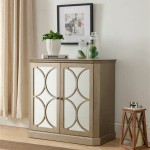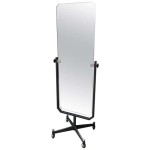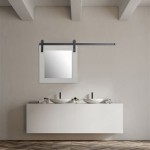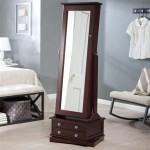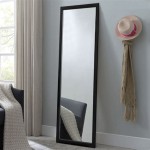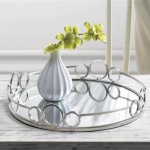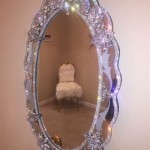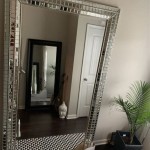Mounting a Heavy Mirror on Wall
Mounting a heavy mirror securely on a wall requires careful planning and execution to ensure both safety and aesthetic appeal. Improper installation can lead to damage, injury, or the mirror falling off the wall. This article outlines the essential steps and considerations for successfully mounting a heavy mirror.
Assessing the Mirror and Wall
Before beginning the mounting process, assess both the mirror and the wall. Determine the exact weight and dimensions of the mirror. This information is crucial for selecting the appropriate mounting hardware. Inspect the back of the mirror for existing hanging hardware or designated mounting points. Some mirrors come with pre-installed D-rings, wire, or cleats. Understanding the mirror's structure will inform the best mounting method.
Next, assess the wall type. Different wall materials require different fasteners. Drywall requires specialized anchors, while concrete or brick walls may need heavier-duty screws or bolts. It is imperative to determine whether the desired mounting location aligns with wall studs. Studs provide the most secure anchoring points, especially for heavier mirrors. A stud finder can be used to locate these structural supports. If studs are not available at the desired location, heavy-duty wall anchors rated for the mirror's weight will be necessary.
Selecting Appropriate Hardware
Choosing the correct mounting hardware is paramount for safety and stability. The hardware must be rated to support the mirror's weight. Consult the packaging of the chosen hardware for weight limits. It is recommended to select hardware that exceeds the mirror's weight to provide a safety margin. For very heavy mirrors, consider using multiple mounting points.
Several hardware options are available, each with its own advantages and disadvantages. For mirrors with D-rings or wire, D-ring hangers or heavy-duty picture hooks can be used. These are suitable for lighter to medium-weight mirrors. For heavier mirrors, consider using J-hooks or French cleats. French cleats offer a particularly strong and stable mounting solution, distributing the weight evenly across the cleat. Toggle bolts or molly bolts are recommended for mounting into drywall when studs are unavailable. These anchors expand behind the wall, providing a secure grip. For concrete or brick walls, masonry screws or anchors are required. Ensure the chosen screws are the correct length and diameter for the wall material and the anchors being used.
Installation Process
Begin by marking the desired location of the mirror on the wall. Use a level to ensure the markings are straight and even. If using D-rings or wire, measure the distance between the rings or the wire hanging points. Transfer these measurements to the wall markings to determine the placement of the mounting hardware. This ensures the mirror hangs level.
If mounting directly to studs, pre-drill pilot holes slightly smaller than the screw diameter to prevent the wood from splitting. If using anchors in drywall, follow the manufacturer's instructions for installation. For concrete or brick walls, a hammer drill and appropriate masonry drill bit are necessary to create pilot holes. Once the pilot holes are drilled, carefully attach the chosen mounting hardware to the wall, ensuring it is securely fastened.
Next, carefully lift the mirror and align the hanging hardware with the wall-mounted hardware. For D-rings and hooks, simply hang the D-rings onto the hooks. For French cleats, engage the two parts of the cleat together. For other mounting systems, follow the manufacturer's instructions for proper attachment. Once the mirror is in place, double-check its stability and levelness. Gently shake the mirror to ensure it is firmly mounted. Use shims if necessary to adjust the level and create an even gap between the mirror and the wall.
After confirming the mirror is secure and level, clean the mirror surface and surrounding area. Dispose of any packaging materials and leftover hardware safely. Regularly inspect the mounting hardware for any signs of loosening or wear over time. This is especially important for heavy mirrors. Tighten any loose screws or bolts as needed to maintain a secure and safe installation.
Safety Precautions
Safety should be the primary concern throughout the entire mounting process. Always wear appropriate safety glasses and gloves when handling tools and hardware. Use a sturdy ladder or step stool when working at heights, ensuring it is placed on a stable and level surface. If the mirror is exceptionally heavy, enlist the help of another person to lift and position it safely. Never attempt to lift a mirror beyond your physical capabilities. If unsure about any aspect of the installation process, consult a professional handyman or contractor. Prioritizing safety will mitigate the risk of accidents and ensure a successful and secure mirror installation.

How To Hang A Large Or Heavy Mirror

How To Hang A Heavy Mirror Diy Family Handyman
How To Hang A Heavy Mirror On Drywall Quora

How To Hang A Very Heavy Picture Or Mirror The Best

How To Hang A Heavy Mirror C R F T

How To Hang A Heavy Mirror Or Picture True Value
:strip_icc()/ScreenShot2022-04-28at1.12.19PM-e055476c70c6438585fa7c5cd531edcf.png?strip=all)
4 Easy Ways To Hang A Heavy Mirror

How To Hang A Heavy Mirror C R F T

How To Hang A Heavy Mirror

How To Hang A Heavy Mirror With Pictures Wikihow

